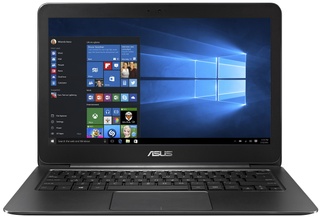Asus ZenBook UX305FA 13.3" Intel Core M 5Y10 vs Huawei MateBook D 14 (2023) 14" Intel Core i5-1155G7
Welcome to our in-depth analysis of the Asus ZenBook UX305FA and the Huawei MateBook D 14. This guide, delivered with confidence yet approachability, scrutinizes each laptop's main features - from processing power to storage capabilities. The Asus ZenBook is equipped with an Intel Core M 5Y10 processor and a decent 256GB of storage, while the Huawei MateBook ups the game with an Intel Core i5-1155G7 processor and an impressive 512GB SSD. But which one suits you best? We're here to simplify that decision for you, offering a balanced view on both models' pros and cons. From design preferences to durability inquiries, we've got all bases covered. Let's get started!
System and application performance
Performance in popular 3D games
Viewing angle, color accuracy...
Ports, webcam and other interfaces
Potential battery life
Materials, durability and portability
Performance Comparison
| Asus ZenBook UX305FA 13.3" Intel Core M 5Y10 | Huawei MateBook D 14 (2023) 14" Intel Core i5-1155G7 | |
|---|---|---|
| Passmark | 1878 | 10345 |
| Passmark Single | 1100 | 2939 |
Comparing the Asus ZenBook UX305FA and the Huawei MateBook D 14 for performance requires a detailed examination of specific benchmarks to determine their strengths in practical tasks.
Performance Benchmarks:
- Passmark Comparison:
- Asus ZenBook UX305FA:
- Total Passmark: 1878
- Passmark Single Core: 1100
- Huawei MateBook D 14:
- Total Passmark: 10345
- Passmark Single Core: 2939
Analysis:
- Rendering and Design Software:
- The Huawei MateBook D 14 stands out for its higher Passmark scores, especially in single-core performance, making it excellent for rendering tasks in design software such as Adobe Photoshop or AutoCAD. Its Intel Core i5 processor delivers smoother and faster rendering speeds than the Asus ZenBook UX305FA, catering to creative professionals who depend on swift processing power.
- Gaming Frame Rates:Gaming enthusiasts will appreciate the Huawei MateBook D 14's powerful processor, providing an enhanced gaming experience with smoother frame rates and improved graphics rendering. Demanding games will run more seamlessly on this model than on the Asus ZenBook UX305FA.
- Business Applications Speed:
- For general business applications like Microsoft Office suite or accounting software, both laptops are capable of handling routine tasks efficiently. Nonetheless, the Huawei MateBook D 14's superior processing power could result in faster response times and overall smoother performance, especially when multitasking or managing resource-intensive business applications.
Conclusion:
The Huawei MateBook D 14 surpasses the Asus ZenBook UX305FA in overall performance based on benchmark scores, making it the top choice for users who value speed and efficiency in demanding tasks such as design work, gaming, or multitasking with resource-heavy applications.
Design Comparison
Size Comparison
When looking at the design features that improve user experience on the Asus ZenBook UX305FA and Huawei MateBook D 14, we notice distinct elements that cater to various user requirements.
Design Elements Enhancing User Experience
Ergonomics
- Asus ZenBook UX305FA: With its slim and lightweight design, the Asus ZenBook is highly portable and perfect for students or professionals needing to work on-the-go.
- Huawei MateBook D 14: The Huawei MateBook features a backlit keyboard that improves visibility in low-light settings, making it useful for users who work during late hours or in poorly lit spaces.
Materials & Build Quality
- The Asus ZenBook and Huawei MateBook both boast premium materials that enhance their durability and aesthetic appeal. Their sleek metal finishes offer a modern and professional appearance ideal for diverse environments.
Portability
- Asus ZenBook UX305FA: The Asus ZenBook features a smaller 13.3-inch screen, making it more compact and convenient for users who value portability over the larger 14-inch display of the Huawei MateBook.
- Huawei MateBook D 14: The Huawei MateBook D 14 features a larger screen, providing an enhanced viewing experience ideal for multitasking or content creation tasks that benefit from more screen space.
Unique Design Features
- Asus ZenBook UX305FA: Its multiple USB 3.0 ports and HDMI output ensure effortless connections to external devices, ideal for users who often transfer data or link to external displays.
- Huawei MateBook D 14: With USB Type-C and USB 2.0 ports, as well as Wi-Fi 6 support, the Huawei MateBook offers enhanced connectivity options ideal for users who value quick data transfers and wireless capabilities.
Practical Usability & Aesthetic Appeal
- Students: The Asus ZenBook is a convenient choice for students looking for a laptop that is compact and lightweight, making it easy to carry in a backpack.
- Professionals: The backlit keyboard on the Huawei MateBook appeals to professionals working in low-light environments or during late hours, enhancing productivity with clear key visibility.
Impact on Overall Experience & Value
Both laptops have distinct design elements tailored to different user preferences. The Asus ZenBook focuses on portability and connectivity options, whereas the Huawei Matebook emphasizes improved visibility with its backlit keyboard and advanced connectivity features.
In summary, potential buyers should evaluate their individual requirements for portability, viewing quality, and connectivity needs to decide between the two laptops. The Asus ZenBook suits those who prioritize portability and diverse connectivity, whereas the Huawei Matebook offers a larger screen and backlit keyboard for users focusing on better visibility and advanced connectivity.
Screen Comparison
| Asus ZenBook UX305FA 13.3" Intel Core M 5Y10 | Huawei MateBook D 14 (2023) 14" Intel Core i5-1155G7 | |
|---|---|---|
| Resolution | Full HD | Full HD |
| Screen Size | 13.3" | 14" |
Asus ZenBook UX305FA 13.3" vs. Huawei MateBook D 14: Screen Comparison"
This heading compares the screens of the Asus ZenBook UX305FA 13.3" and the Huawei MateBook D 14 models.
When comparing the screens of the Asus ZenBook UX305FA and the Huawei MateBook D 14, it's crucial to consider screen size and resolution.
Screen Size:
- Asus ZenBook UX305FA (13.3"):
- This laptop features a compact 13.3-inch display that combines portability with an excellent viewing experience.
- Perfect for users who value portability and prefer a compact design.
- Huawei MateBook D 14 (14"):
- This model offers a more immersive visual experience with its slightly larger 14-inch screen, providing increased screen real estate.
- Ideal for users who favor bigger screens to boost productivity or enjoy entertainment.
Screen Resolution:
- Both laptops provide a Full HD resolution of 1920 x 1080 pixels, delivering sharp and detailed visuals for a variety of tasks.
Impact on Gaming and Graphic Design:
- Gaming: The Asus ZenBook UX305FA's higher pixel density could deliver sharper image quality than the MateBook D
- Yet, the MateBook's larger screen size may provide a more immersive gaming experience with better visibility and detail.
Graphic Design: Graphic designers might find the Asus ZenBook appealing for detailed image editing due to its higher pixel density. On the other hand, those handling intricate projects could find the Huawei MateBook beneficial for its larger display area.
Supported Displays:
- The Asus ZenBook can connect to three external displays, giving you more flexibility for multitasking or expanding your workspace.
The Huawei MateBook can support up to four external displays, making it ideal for professionals who need a lot of screen space for multitasking or creative projects.
In summary, both laptops feature Full HD displays with comparable resolutions. The decision between them hinges on personal preferences regarding screen size and intended usage. Those valuing portability may lean towards the compact Asus ZenBook UX305FA, while individuals looking for increased productivity or immersive visuals may choose the larger Huawei MateBook D 14.
Hardware Comparison
| Asus ZenBook UX305FA 13.3" Intel Core M 5Y10 | Huawei MateBook D 14 (2023) 14" Intel Core i5-1155G7 | |
|---|---|---|
| CPU | Intel Core M | Intel Core i5-1155G7 |
| RAM | 8GB | 8GB |
| Storage Size | 256GB | 512GB |
When evaluating the hardware features of the Asus ZenBook UX305FA 13.3" and the Huawei MateBook D 14 (2023), it's important to consider how critical elements like CPU, GPU, RAM, and storage influence real-world applications like multimedia activities or running resource-intensive software.
Asus ZenBook UX305FA 13.3
- CPU: Intel Core M 5Y10
- *Performance Impact:* The Intel Core M 5Y10 processor is designed for power efficiency rather than raw performance. It is suitable for light productivity tasks but may struggle with demanding software.
- GPU: Integrated Graphics
- *Performance Impact:* Integrated graphics are sufficient for basic multimedia tasks but may not handle graphically intensive applications or gaming smoothly.
- RAM: 8GB LPDDR3 RAM
- *Performance Impact:* With a lower RAM speed of 1600 MHz, multitasking capabilities might be limited compared to higher-speed RAM options.
- Storage: 256GB Flash Storage
- *Performance Impact:* Although this device boasts fast read/write speeds, its storage capacity may fall short for users who need a lot of space for multimedia files or large software installations.
Huawei MateBook D 14 (2023)
- CPU: Intel Core i5-1155G7
- Performance Impact: The Intel Core i5-1155G7 processor provides faster clock speeds and increased cores/threads compared to the Core M series, enhancing its ability to multitask and efficiently manage heavier software loads.
- GPU: Integrated Graphics
- *Performance Impact:* Similar to the Asus model, integrated graphics on this Huawei laptop provide satisfactory performance for everyday tasks but might struggle with demanding graphics applications.
- RAM: 8GB DDR4 RAM at a higher speed of 4267 MHz
- *Performance Impact:* The faster RAM speed enables smoother multitasking and better overall system responsiveness compared to lower-speed options like LPDDR3.
- Storage: 512GB NVMe SSD*Performance Impact:* This SSD provides faster data access speeds due to its double storage capacity and NVMe technology, making it ideal for users handling large media files or running data-heavy applications.
Conclusion:
- For individuals focusing on portability and light tasks, the Asus ZenBook UX305FA might be a good choice. On the other hand, users requiring enhanced processing capabilities for multitasking or demanding applications may prefer the Huawei MateBook D 14 (2023) due to its superior CPU performance, faster RAM speed, and larger NVMe SSD storage.
Verdict
Why Asus ZenBook UX305FA 13.3" Intel Core M 5Y10?
- Asus ZenBook UX305FA offers a more portable and compact design with a 13.3-inch screen.
- Asus ZenBook UX305FA provides multiple USB 3.0 ports and HDMI output for convenient connectivity to external devices.
- Asus ZenBook UX305FA is a suitable choice for users prioritizing portability and diverse connectivity options.
Why ?
- The Huawei MateBook D 14 features a more powerful Intel Core i5-1155G7 processor compared to the Asus ZenBook UX305FA's Intel Core M 5Y10, offering superior performance for demanding tasks.
- With a larger 512GB NVMe SSD storage capacity, the Huawei MateBook provides ample space and faster data access speeds for handling large media files and data-heavy applications.
- The Huawei MateBook D 14 boasts a higher RAM speed of 4267 MHz, enabling smoother multitasking and better system responsiveness than the Asus ZenBook UX305FA's lower-speed RAM option.
Similar comparisons
- Asus ZenBook UX305CA 13.3" Intel Core m3-6Y30 vs HP 15-dy2024nr 15.6" Intel Core i5-1135G7
- Asus Zenbook S 13 OLED (UM5302) 13.3" AMD Ryzen 7 6800U vs Dell Alienware X16 (2023) 16" QHD Plus Intel Core i9-13900HK
- Asus Zenbook S 13 OLED (UM5302) 13.3" AMD Ryzen 7 6800U vs Asus Zenbook S 13 OLED (UX5304) 13.3" Intel Core i7-1355U
- Asus ZenBook 14 UX425 Intel Core i7-1065G7 vs Razer Blade Stealth RZ09 12.5" Intel Core i7-7500U
- Asus ZenBook Flip S vs Dell XPS 13 9365 13.3" Intel Core i7 7Y75 16GB 512GB

